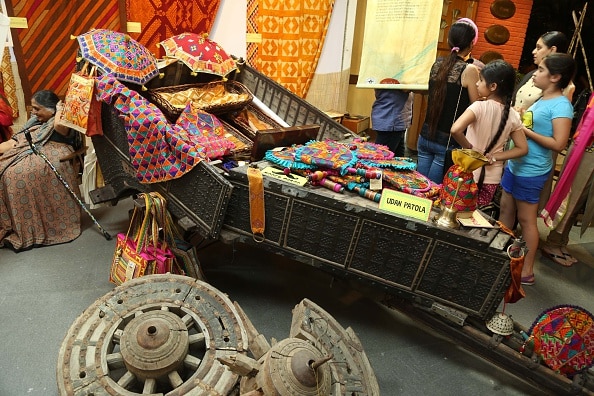National Handloom Day 2023: The Journey Of Punjab's 'Phulkari'- From The Timeless Tales Of 'Heer Ranjha' To Modern Fashion
'Phulkari' refers to Punjabi traditional needlework. This style of clothing art is created on Kurtis, dupattas, stoles, sarees, salwar suits, and juttis.

New Delhi: The word ‘Phulkari’ immediately brings the image of Punjab in our minds. This special dupatta holds an integral part in the wedding ceremonies of Punjab and is the first gift by a mother-in-law to her daughter in law. 'Phulkari' refers to Punjabi traditional needlework. Although it refers to flowers, the designs also feature geometrical patterns, which consist of flowers (phul) and shapes (Akari). This style of clothing art is created on Kurtis, dupattas, stoles, sarees, salwar suits, and juttis.
Origin Of Phulkari:
The origin of Phulkari dates back to very ancient times in Punjab when the mothers and grandmothers used to start embroidering phulkaris as soon as a daughter was born in their house to gift her on her wedding day. This is because they believed that the girl child would be the creator for the forthcoming generations and also because these Phulkaris were to be given away at the time of her marriage.

"These phulkaris used to be also gifted in dowry in numbers from 11 upto 101 depending upon the financial status,"said Lovish Goyal, Managing Director of Goyal Cloth house.
Digging a bit into history, Debroopa Bhattacharyya, designer of Ummaira said, "Some historians date phulkari back to the seventh century while others say it is a borrowed embroidery technique from Iran where it is called 'Gulkari'. Phulkari finds pride of place in Waris Shah's famous love story of the middle ages, 'Heer Ranjha' .The popularity dates back to the reign of Maharaja Ranjit Singh in the fifteenth century. A woman's life included religious ceremonies, weddings, and births that all required the use of 'Phulkari'."
Evolution Of Phulkari:
"The Phulkari style of embroidery met with a tragedy and faced some very difficult times but at some point in time, around 52 types of Phulkari existed. There was also a time where this form of embroidery almost disappeared. This happened during the partition of India and Pakistan in 1947. However, it soon came back and now almost 70 years later, it is an evergreen style statement. The revival of Phulkari resulted because after the partition in 1947, due to the refugee crisis, the organizations encouraged women to make Phulkaris so that they could earn enough money to survive. Traditionally, Phulkari was embroidered by women using their own hands but now, the Phulkaris are embroidered using machines and modern techniques and materials," said Lovish.
Types Of Phulkari Embroidery:
The vivid and exquisite thread work with floral designs that comes to mind when we hear the word 'phulkari' is ubiquitous. Phulkari is a form of aesthetic craftsmanship, although it encompasses much more than mere blossoms. It looks vibrant and exquisite because of the hand-embroidered patterns. This handmade item stands out because of the darn stitching technique applied on the fabric's reverse side.
Senchi- The Senchi motif shows rural life and features ploughing, harvesting, a water bearer, a burning hukkah, drinking, hawkers, and domestic activities like churning, spinning, and weaving. In other words, the entirety of village life is portrayed. The simple red and black khaddar veil is worn daily and referred to as (saloo).
Saloo- This is a simple red khaddar shawl for everyday use. It has floral Buti embroidered at a distance in the shawl's field.
Chope- Chope is a phulkari technique that is stitched on both sides of a fabric.
Sheeshedar phulkari- This phulkari is embellished with small mirrors that are attached with a buttonhole stitch. The base colour is red or brown, and the embroidery is done in yellow or blue thread.

The Making Of Phulkari:
The Phulkari embroidery is created with colourful silken thread and a darn stitch on the back of khaddar, a coarse cotton fabric. The primary attribute of this kind of needlework is this.
"Phulkari embroidery used to be used on shawls and Odhani in the past solely. However, in modern times, sarees and churidar kameez are used as vast canvases for this needlework. The darning stitch, which is the most significant stitch in this Phulkari embroidery, is employed. Many other stitches are employed, such as the running stitch, button stitch, and herringbone stitch. These stitches were used to border the khaddar or to make an attractive design. Typically, these patterns and motifs are stitched from the underside of the fabric, and the finer the thread, the more intricate the work becomes," said Debroopa.
Impact Of Phulkari In Present Times:
In this regard, Debroopa said, "The Partition of India and other events left the ladies who had previously performed phulkari needlework too traumatised to do so. Phulkari, prized treasures from earlier times and a symbol of brighter days, appeared to be gone forever. But not for very long. It quickly recovered and gained popularity. With commercialisation, more efficient production methods were developed. Today, depending on our preferences and financial constraints, we can buy both hand- and machine-made phulkari."
"Nowadays, Phulkari jackets, pouches, clutches, umbrellas, dupattas or stoles, cushion covers, sarees and even Phulkari juttis are available, but this wide spread commercialization of Phulkari has led to its degradation also. Cheap imitations and machine made Phulkaris are on the rise as there is shortage of time," said Lovish.
"Phulkari is one of the most sought after embroidery crafts of India! The intricacies of the motifs that over the entire fabric, each thread is counted and embroidered. Traditionally women made dupattas for their weddings using phulkari, but now it’s a craft loved and appreciated by everyone," concluded Matrika Bhandari from Inkriti.





































